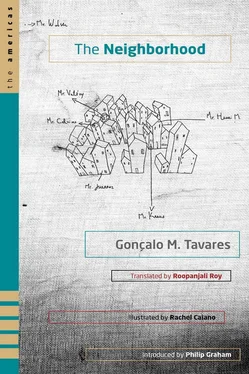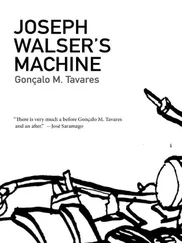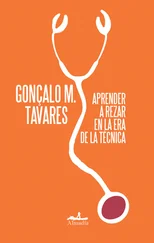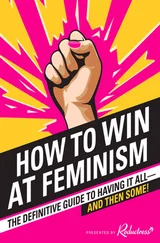He explained, “Sometimes, on certain nights, right before my very eyes, in my own house, objects appear that I have never seen in my life. They are objects that belong to the people who formerly owned this house, objects that broke or were destroyed. I look at my table and I see a glass on it that I never owned. I glance at the corner of the room and I find a stepladder there that I never bought. Once,” explained Mister Valéry, “I tried to climb the phantom stepladder, and I fell down. Quite suddenly, the stepladder simply disappeared. I could have broken a leg but, fortunately, in the meanwhile, a phantom mattress appeared below me and cushioned the fall.”
At this point in his explanation, someone asked him to draw a phantom stepladder, and Mister Valéry amiably acquiesced to this request and drew
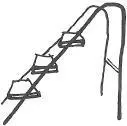
“But that is a stepladder just like any other,” they told him.
“It’s just like any other stepladder,” explained Mister Valéry, “except it cannot be seen.”
He then turned his back on these people who irritated him with their remarks, and had already walked a fair distance when, suddenly, he muttered to himself, “They ask me to draw a phantom and then complain about the drawing. That’s just how men are.”
And with small and rhythmical steps, Mister Valéry continued to walk away from that group of men, step by step, without looking back even once.
Sadness

Mister Valéry always walked along the same streets in the city with the same shoes, one pair for each street.
He had lived there ever since he was born, but knew only five streets, which he walked along with five different pairs of shoes.
Mister Valéry explained, “It’s just that I absorb too much. It’s as though when I walk down a new street the ground sticks to my shoes and nobody else has space to put their feet. It’s as though from then on only birds could traverse the street,” he ended, on a poetic note, which was rather rare for him, as he was a man who prided himself on logic.
“The problem,” explained Mister Valéry, “does not lie in the shoes, it lies in my desire to take everything I touch home.”
And Mister Valéry clarified, “As I do not feel complete just as I am, I think that everything that I am not could complete me, and thus I want it for myself, and I steal it from the rest of the world. In truth, the streets attach themselves to my shoes because I am unhappy,” said Mister Valéry, melancholically.
And, recovering his habitual ability for logical reasoning, further added, “If a right-angled triangle were to miss the time when it was a square and wished to be a square once again, it should not attach itself to what it wishes to be (the square), as it will thus never be what it wishes to be.”
And after this somewhat confused observation, Mister Valéry found himself obliged to draw a sketch to clarify the idea.
“Well now, look what happens if the right-angled triangle were to attach itself to the shape that it wishes to become, that is, the square.” And Mister Valéry drew
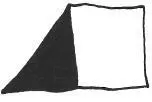
Essentially,” said Mister Valéry, while he drew another sketch, “we should instead attach ourselves to precisely that which we do not like to be, to thus be able to become what we wish to become.”
And Mister Valéry drew
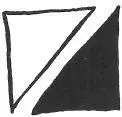
“And this is far too confusing, and it’s also rather sad,” he said, in conclusion.
Mister Valéry did not say anything else after this — he was already tired and it was quite late — however, the last drawing he made was that of a square divided into many small bits.
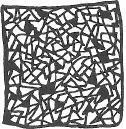
Mister Calvino’s First Dream

From over thirty stories above, someone flung Mister Calvino’s shoes and tie out of the window. Calvino had no time to think, he was late, he likewise flung himself out of the window in pursuit. While still in the air he reached his shoes. First, the right shoe: he put it on; then the left shoe. In the air, while falling, he tried to find the best position in order to tie his shoelaces. He failed to tie his left shoelace, but he tried again, and this time he succeeded. He looked down, he could already see the ground. First, however, the tie; Calvino was upside down and with a brusque movement his right hand caught his tie in the air and then, with hurried but sure fingers, he twisted it and formed a knot: his tie was in place. He looked at his shoes once again: his shoelaces were firmly tied; he gave the last finishing touches to the knot on his tie, just in time, the moment had come: he touched down on the ground, impeccable.

Mister Calvino’s Second Dream

Suddenly, a butterfly. Calvino closed the windows: he didn’t want it to be able to get out.
The butterfly settled on his shadow as though it were a surface — a fine black carpet — and not just an illusion.
However, immediately afterward, the butterfly flew off, and settled on the legs of a beautiful woman, who was wearing the skimpiest of skirts; it then flew to the table and settled on the open pages of an algebra book. Calvino watched: the butterfly’s tiny feet were on a second-degree equation. Calvino looked at it, at the equation, and then at the butterfly, but the latter flew off again, this time toward the kitchen. Calvino followed it and then froze. There was a raw steak on top of the table, the butterfly circled the meat, but Calvino’s hand waved it away in time — certain combinations are unlucky. The butterfly flew out of the room. It first settled on a painting and then flew off again and came near Calvino’s left ear.
Calvino felt the colors approach his ear and smiled, he continued to smile while the butterfly entered through his ear, step by step, wing by wing, and went inside his head. Now it was inside and was flapping around his head, its small wings opened and closed delicately and Calvino felt from that moment onward he didn’t have to think of anything else, as though the world was, finally, all thought out and resolved, without the need for any human abnegation. Calvino felt happy.
However, still in his dream, Calvino woke up. A strong headache: and it seemed reluctant to go away.

Mister Calvino’s Third Dream

He was so involved in a discussion with his partner about the percentages of something that he didn’t even notice what had happened: they had been swallowed up by a whale. Inside the whale’s stomach, Calvino continued to discuss percentages. He now understood the deal they were discussing, it involved the sale of petroleum and books. Who would get what? The discussion became heated and Calvino got increasingly caught up in it; he then turned his back on his partner and went out into the street: he observed passersby walking from one side to the other. The few that were not in a hurry, the ones who stopped and also discussed percentages among themselves: 30, no, 37! no, no, 32! Everybody was arguing, Calvino couldn’t help but repeat, to himself: 43 percent, at least 43 percent!
Читать дальше
